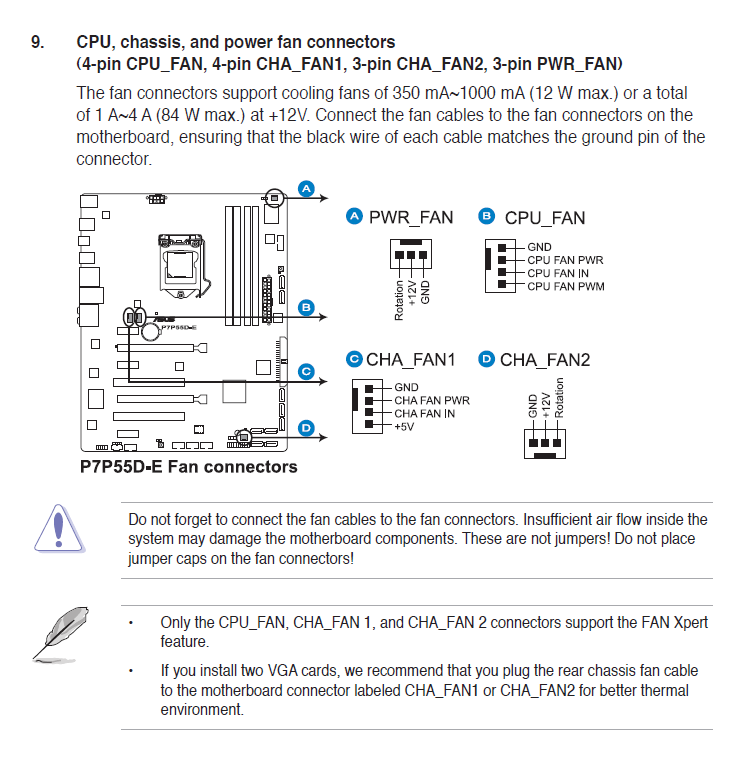I have a question regarding fan RPM/noise management which I'm hoping you clever folks can help with...
First, here's the situation: I've built a new system (partially using advice from this forum) and am very happy with it but would like to decrease the fan noise a bit. I've done some research on this wonderfully resourceful site and have decided to purchase two Scythe S-Flex Fans (SFF21E and SFF21F) to replace the rear stock (TriCool) chassis fan and the somewhat noisy Coolermaster 120mm Rifle fan I temporarily have attached to the heatsink.
My question has to do with PWM and how I can use it to achieve my silencing goals or whether I should be using an alternate solution given my hardware. The relevant hardware consists of:
Antec P183 case
ASUS P7P55D-E motherboard
Thermalright Venomous X heatsink
Here is a diagram of my mobo with the fan connectors notated, borrowed from the ASUS manual -->

Any guidance on this topic would be terrific! You can read more details including some of my thoughts and questions on this topic as it might be helpful understanding where my ignorance lies.
Thanks!
Dave
[ optional reading
I'm looking to keep my box relatively cool, but also very quiet. (The idle temps with stock hardware were in the 48-50C range and I've been able to get that down to the mid-30s with the addition of the Venomous heatsink and CM fan). Now I just need to get the fans quieter. BTW, following some reviews and suggestions on the P183, I've disabled the top case fan and covered the grill and that has reduced the noise quite a bit.
For some reason only the CPU_FAN seems to support PWM. I was thinking I would use this connector for the Scythe CPU Fan but the fan only has a 3 pin connector, and the mobo calls for a 4 pin and the 4th pin is for PWM. Does this mean the 3 pin fan would not be adjustable using PWM and if so, how else can I adjust the CPU fan speed?
I've noticed many fans are sold with 3 pin connectors but advertised with 3 to 4 pin adapters but the 4 pin adapters are (always?) the large molex power connectors and not the small 4 pin connector that would plug into a motherboard. So, I'm uncertain how the 3-4 pin adapter helps in this case. Yes it supplies power, but can the molex PSU connector be used to modify fan speeds?
My mobo also has a 4 pin CHA_FAN1, but this does not appear to support PWM from the diagram. There are also the PWR_FAN and CHA_FAN2 connectors which are both 3 pin and appear identical in their function. I only want to have the 2 fans mentioned above in my system for now, so if I can successfully use these mobo connectors to adjust fan speed, that would be good.
I've read a bunch about changing fan speeds by alternating voltage and/or using BIOS settings or fan controllers, but I'm not sure what would make the most sense for my equipment. I'd like to not have to purchase too much additional equipment and instead use what I have already if that will achieve the (near)-silent computing goal. I've used the BIOS Q-FAN feature with limited success as it doesn't seem to alter the fan speed much for the CPU (maybe the CM fan doesn't support PWM?). I've also used Speedfan and it successfully changes fan speeds but doesn't properly report the RPM changes. I'm willing to do some modding to the PSU if necessary, but would prefer to not have to do that.
Thanks in advance for any guidance in my quest for a near-silent PC!
- Dave
